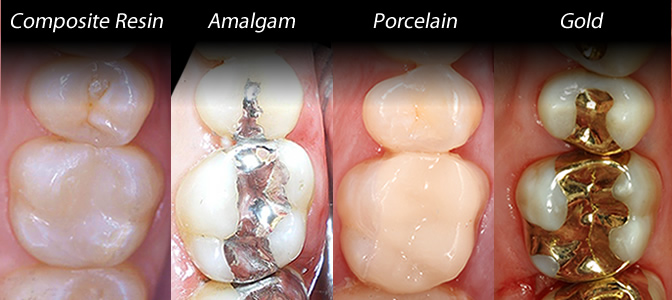Whenever an individual is faced with a dental cavity, chipped or broken tooth, a vital decision must be made. This decision does not always involve extracting the tooth; there are other alternatives that include dental fillings. A filling help to restore a tooth damaged by decay back to its normal shape and function. It also helps to prevent further decay by eliminating areas where bacteria can enter the tooth. There are some instances where the tooth may be too damaged to the extent that it can only be extracted.
Types of Dental Fillings
-
Amalgam Fillings
Used by dentists globally for more than a century, dental amalgam is the most common type of dental filling and the most researched. It is an amalgamation of various metals that include Silver, mercury, copper and tin. It is also relatively inexpensive compared to other options.
Pros
- Strong : Amalgam fillings are strong. They can withstand forces of chewing.
-
Cost : They are the least expensive type of restorative material
-
Easy : Only one dental session is required for this procedure.
-
Sensitivity : Compared to other restorative material, there are not as sensitive to moisture.
Cons
-
- Amalgam fillings tarnish or corrode over time. This can bring about discoloration where the tooth meets filling.
- Amalgam does not match the color of the teeth.
- Mercury : They have been concerns about the use of mercury and their long term effects. Some people even have some allergic reactions towards metal.
-
Composite Filling
This type of filling is matched to be the same color with teeth and hence used where a natural appearance is desired. They are made from resin or glass quartz. There are two types, direct and indirect. Direct is takes only one session by a dentist. Indirect can take two sessions. In the first session the dentist analyses the gap to be filled and in the next session he completes the process.
Pros
- Aesthetic : Your inlay or fillings will match the colour of your teeth.
-
Easy : Less drilling is required unlike amalgam filling. Additionally, it can be done in one sitting.
-
Strong : can directly bond to the tooth, making it stronger that it would be with Amalgam filling.
-
Bonding : Bonds perfectly and more closely into the gap hence making it strong.
Cons
-
- Expensive : It costs more than Amalgam.
- Takes longer to place : This is because they are usually placed in layers. This increases labour time and hence higher charges.
-
Cast Gold Fillings
Just as the name suggest these fillings are made from gold although they contain some other metals. Typically, they consist about 75% gold. It can be used for onlays, inlays, and crowns.
Pros
-
- Durable : Gold does not corrode. They last longer than any other fillings.
-
Aesthetic : A majority of people likes the colour of gold better than silver amalgam.
-
Strong : Gold fillings are strong enough to withstand the forces of chewing.
Cons
-
- Costly : The cost is high due to the high cost of gold. It can be six times more expensive than silver amalgam.
- Colour : Gold colour is very conspicuous and can easily be noticed. This can be a problem for many.
-
-
Porcelain
They can be used for onlays, inlays, crowns, veneers among others.
Pros
-
- Stain : They can resist staining and does not lose colour as easily as amalgam fillings do.
-
Aesthetic : The material makes it look exactly like the real tooth.
Cons
- Weak : They are not as strong as composite or amalgam fillings.
-
No option can be said to have the upper hand than the other. People choose the filling options depending on their preferences and needs. However, for those seeking less expensive alternatives, cost can be a major factor.
Bottom Line
Nobody would want to get a cavity, but when you do, the best way to treat it is to get a dental filling. Our dentists at Carrum Downs Dental Clinic will recommend the specific materials and procedure based on the location and size of your cavity. Remember, at Carrum Downs Dental Clinic, your dental health is our top priority, every time. Visit us today and restore your beautiful smile.


